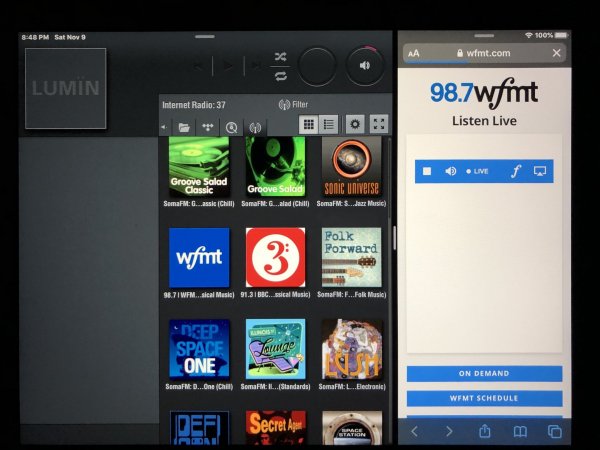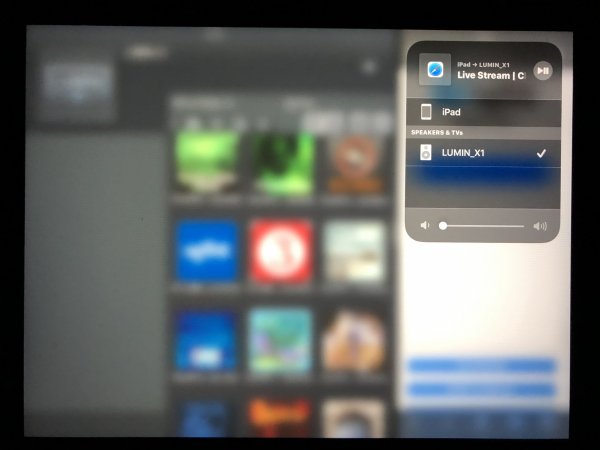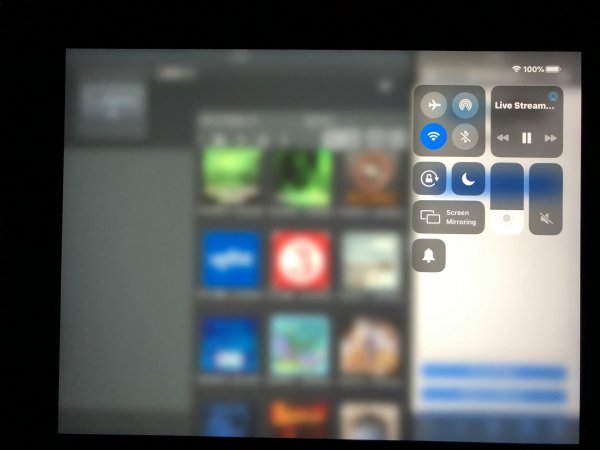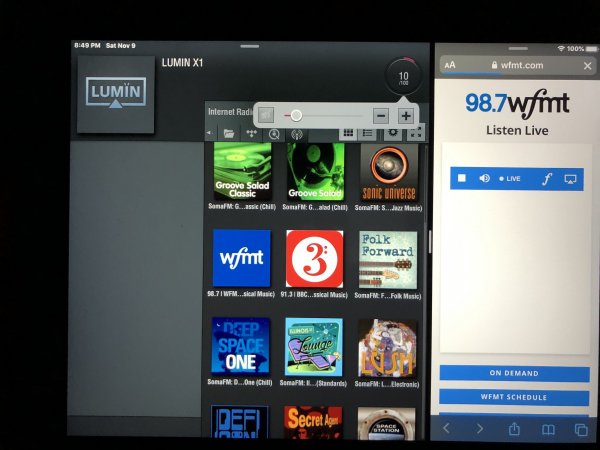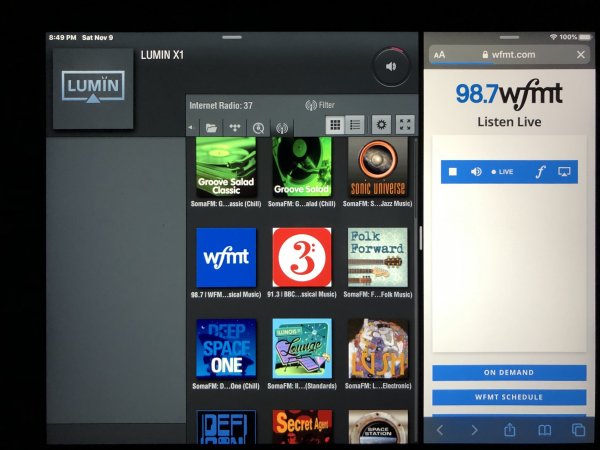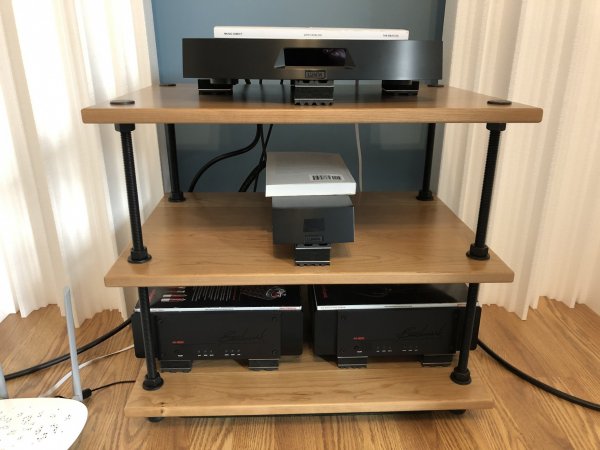I have replaced the Lumin U1 Mini + Sbooster Power Supply with the two-chassis top-of-the-line Lumin X1. Not that there was anything "wrong" with the U1 Mini with Sbooster Power Suppy. The X1 just takes the performance to a yet higher level and adds an extremely competent DAC to the streaming package.
As it has turned out, the swapping of the X1 for the prior U1 Mini has also replaced both my Benchmark DAC3 HGC and Benchmark HPA4. This has allowed my current system to get even simpler than the one I recently described in my Gradient 1.4 thread.
How's that, you ask? After about 1,000 hours of break in, I tried comparing the sound of the Lumin X1's analog balanced outputs with the Lumin App's volume control defeated fed into the Benchmark HPA4 and then to my Benchmark AHB2 amps to the sound with the Lumin X1's digital volume control activated directly feeding the AHB2 amps. To my great surprise (given how highly I thought of the Benchmark's relay controlled analog volume control) it did not take long at all to convince me beyond a doubt that actually the sound is yet cleaner, more three dimensional, and with a substantially larger, more wrap-around stage and greater image focus when the Lumin X1 volume control is used so that the Lumin's balanced analog output directly feeds the balanced analog inputs of the Benchmark AHB2 amps. The Benchmark HPA4 was actually getting in the way of the best sonics. I would not have believed it if I hadn't heard it. It's not even a very subtle difference. I note that on the Lumin Forum, the lead designer has stated that Lumin's reference set up for the X1 has it directly feed Lumin amps.
So my basic electronics chain in the audio room is Lumin X1 to Benchmark AHB2 amps, to Gradient 1.4 speakers. The X1 pulls disc-sourced content from my networked computer, and natively supports Qobuz, Tidal, Spotify, and Tune-In Radio. An Apple iPad acts as the remote control for the X1's Lumin App and the source for AirPlay (aka Lumin Streaming) sources such as other streaming sources (e.g., Sirius/XM, Jazz Radio) and internet radio streams which aren't part of Tune-In Radio. That's it.
Set Up
I treated all the non-soldered electrical connections of the components and connecting cables with the JENA Electrical Contact Enhancement Fluid recommended by P.I. Audio.
I did not try the X1 with its stock power cord. I do, however, use the DC cable between the X1 power supply chassis and the X1's main chassis. From the beginning I used the Triode Wire Labs Digital American power cord I'd been using lately. That power cord, like the others in the system, is plugged into one of two P.I. Audio UberBUSSes. I use one Uber for the analog components—the two Benchmark AHB2 amps—and the other Uber for the digital components—the X1 and my TP Link router. Each UberBUSS, in turn is plugged into a dedicated 20-amp circuit where the outlets are the same hand-customized Pass & Seymour 5362A receptacles P.I. Audio used in my UberBUSSes.
Since the X1 power supply is quite light-weight, I use four of the rubber version of the 2-inch Low Density (LD) Equipment Vibration Protectors (EVPs) from A/V RoomService placed at the center of the edge of each side of the chassis. For the main chassis I use four of the rubber 2" Medium Density (MD) EVPs, one centered along each edge of the chassis.
Comparative listening experiments convinced me that, while both the X1 main and power supply chassis seem quite dead in my finger-tap test, the system sounded a bit better with the top of each chassis damped a bit. Thus I placed the same thick Music Direct catalog atop it to damp that chassis cover and a suitably sized thick paperback book atop the power supply chassis so as to damp as much as possible of its chassis top. With this damping, the sound is a bit more focused in all dimensions without causing any decrease in the size of the presentation.
As the remote control for the Lumin X1 I'm using an iPad 6th edition (9.5" screen, not the Pro or Air models,WiFi only, 32 gig). Since this iPad is totally dedicated to controlling the Lumin, I took off all unneeded apps and installed only the apps I use for streaming. Plus, via the Settings menu, I turned off all unneeded functions (a boatload—it takes a while to search all the menus and submenus to find all the settings which can be adjusted to turn off unneeded functionality) just to keep the iPad processor as "unbusy" as possible. This iPad controller works wonderfully and seems totally stable with all internet radio and other functions.
Part of the rock-solid stability of the streaming I'm experiencing is also related to installing the $25 TP-Link Wireless N300 2T2R Access Point as a means of providing the Lumin with a wired ethernet internet connection. None of the Lumin streamers are inherently WiFi capable.
Since I don't have an ethernet connection available in my audio room, the TP Link device is set up in Client Mode to feed the Lumin. In Client Mode the TP-Link doesn't broadcast or extend your router's Wi-Fi. It just receives your router's Wi-Fi signal and provides a wired ethernet connection to devices which are not inherently Wi-Fi capable from its RJ-45 ethernet port on the back of the TP-Link device. After determining a strong Wi-Fi reception spot near my equipment rack, I placed the TP-Link in that spot on the floor next to my equipment rack. From there the TP-Link grabs the WiFi signal from my Xfinity Advanced Gateway and feeds it via a few feet of flat white CAT7 cable to the ethernet connection of the Lumin. The set up of the TP Link is super simple once you see it demonstrated on video (ignore the overly complex user manual!) and takes at most five minutes. I isolate the TP Link from floor-borne vibration by supporting it off the floor with a single carefully placed LD Equipment Vibration Protector (EVP) from A/V RoomService.
While some may object that this TP Link device only works on the 2.4 GHz WiFi band and not the speedier 5 GHz band, this device has been tested by and it seems totally comfortable streaming even DSD 512 material to a Lumin device. Remember that the Lumin is the only device served by the TP-Link set up in Client Mode. And since I'm dealing only with at most 192/24 PCM, I'm sure the TP Link's bandwidth is adequate. If it were not, I would not have the rock-solid stability of connection I now have.
The TP Link uses a 9-volt wall wart switch mode power transformer. The cable on that transformer is not quite long enough to reach my UberBUSS from the good WiFi reception spot where I placed the TP Link without running the power cord in a visible manner. I thus purchased and installed an aftermarket 9-volt iPower power supply from iFi, one having both a much longer cord and claiming to be much quieter in terms of electrical noise.
I have a two-meter Apple charging cord and 12-volt Apple charger that can reach from a wall outlet to my listening seat so that I can always keep the iPad at full charge while continuously streaming music via AirPlay (aka Lumin Streaming) to the Lumin. When not in hand-held use, the dedicated iPad sits on a little stand on the floor near the wall just beyond the carpeted area of the room, just a few feet from and in line of sight of the TP-Link and Lumin. This keeps the charging cord from being a trip hazard when entering the room and keeps the Wi-Fi connection from the iPad to the TP-Link and Lumin strong.
Sometimes I leave the charging cord connected while listening and handling the iPad; other times I disconnect it first. I think I hear a slight sonic improvement favoring the unplugged condition, so for serious listening I sometimes unplug the iPad. However, the sonic difference, if real, is very slight. Running the Speed Test by Ookla on the iPad, the iPad tests at about 500 mbps download, 40 mbps upload from either its stand position or from the listening chair via my Comcast Gigabit internet service. Thus, the iPad is not a bottleneck in the streaming path in any way since its 5 GHz connection download speed exceeds the 2.4 GHz 300 mbps capability of the TP-Link.
As to how I stream my local networked music files from my computer to the Lumin X1, please see this post and this post from my discussion of the Lumin U1 Mini.
[Continued below]
As it has turned out, the swapping of the X1 for the prior U1 Mini has also replaced both my Benchmark DAC3 HGC and Benchmark HPA4. This has allowed my current system to get even simpler than the one I recently described in my Gradient 1.4 thread.
How's that, you ask? After about 1,000 hours of break in, I tried comparing the sound of the Lumin X1's analog balanced outputs with the Lumin App's volume control defeated fed into the Benchmark HPA4 and then to my Benchmark AHB2 amps to the sound with the Lumin X1's digital volume control activated directly feeding the AHB2 amps. To my great surprise (given how highly I thought of the Benchmark's relay controlled analog volume control) it did not take long at all to convince me beyond a doubt that actually the sound is yet cleaner, more three dimensional, and with a substantially larger, more wrap-around stage and greater image focus when the Lumin X1 volume control is used so that the Lumin's balanced analog output directly feeds the balanced analog inputs of the Benchmark AHB2 amps. The Benchmark HPA4 was actually getting in the way of the best sonics. I would not have believed it if I hadn't heard it. It's not even a very subtle difference. I note that on the Lumin Forum, the lead designer has stated that Lumin's reference set up for the X1 has it directly feed Lumin amps.
So my basic electronics chain in the audio room is Lumin X1 to Benchmark AHB2 amps, to Gradient 1.4 speakers. The X1 pulls disc-sourced content from my networked computer, and natively supports Qobuz, Tidal, Spotify, and Tune-In Radio. An Apple iPad acts as the remote control for the X1's Lumin App and the source for AirPlay (aka Lumin Streaming) sources such as other streaming sources (e.g., Sirius/XM, Jazz Radio) and internet radio streams which aren't part of Tune-In Radio. That's it.
Set Up
I treated all the non-soldered electrical connections of the components and connecting cables with the JENA Electrical Contact Enhancement Fluid recommended by P.I. Audio.
I did not try the X1 with its stock power cord. I do, however, use the DC cable between the X1 power supply chassis and the X1's main chassis. From the beginning I used the Triode Wire Labs Digital American power cord I'd been using lately. That power cord, like the others in the system, is plugged into one of two P.I. Audio UberBUSSes. I use one Uber for the analog components—the two Benchmark AHB2 amps—and the other Uber for the digital components—the X1 and my TP Link router. Each UberBUSS, in turn is plugged into a dedicated 20-amp circuit where the outlets are the same hand-customized Pass & Seymour 5362A receptacles P.I. Audio used in my UberBUSSes.
Since the X1 power supply is quite light-weight, I use four of the rubber version of the 2-inch Low Density (LD) Equipment Vibration Protectors (EVPs) from A/V RoomService placed at the center of the edge of each side of the chassis. For the main chassis I use four of the rubber 2" Medium Density (MD) EVPs, one centered along each edge of the chassis.
Comparative listening experiments convinced me that, while both the X1 main and power supply chassis seem quite dead in my finger-tap test, the system sounded a bit better with the top of each chassis damped a bit. Thus I placed the same thick Music Direct catalog atop it to damp that chassis cover and a suitably sized thick paperback book atop the power supply chassis so as to damp as much as possible of its chassis top. With this damping, the sound is a bit more focused in all dimensions without causing any decrease in the size of the presentation.
As the remote control for the Lumin X1 I'm using an iPad 6th edition (9.5" screen, not the Pro or Air models,WiFi only, 32 gig). Since this iPad is totally dedicated to controlling the Lumin, I took off all unneeded apps and installed only the apps I use for streaming. Plus, via the Settings menu, I turned off all unneeded functions (a boatload—it takes a while to search all the menus and submenus to find all the settings which can be adjusted to turn off unneeded functionality) just to keep the iPad processor as "unbusy" as possible. This iPad controller works wonderfully and seems totally stable with all internet radio and other functions.
Part of the rock-solid stability of the streaming I'm experiencing is also related to installing the $25 TP-Link Wireless N300 2T2R Access Point as a means of providing the Lumin with a wired ethernet internet connection. None of the Lumin streamers are inherently WiFi capable.
Since I don't have an ethernet connection available in my audio room, the TP Link device is set up in Client Mode to feed the Lumin. In Client Mode the TP-Link doesn't broadcast or extend your router's Wi-Fi. It just receives your router's Wi-Fi signal and provides a wired ethernet connection to devices which are not inherently Wi-Fi capable from its RJ-45 ethernet port on the back of the TP-Link device. After determining a strong Wi-Fi reception spot near my equipment rack, I placed the TP-Link in that spot on the floor next to my equipment rack. From there the TP-Link grabs the WiFi signal from my Xfinity Advanced Gateway and feeds it via a few feet of flat white CAT7 cable to the ethernet connection of the Lumin. The set up of the TP Link is super simple once you see it demonstrated on video (ignore the overly complex user manual!) and takes at most five minutes. I isolate the TP Link from floor-borne vibration by supporting it off the floor with a single carefully placed LD Equipment Vibration Protector (EVP) from A/V RoomService.
While some may object that this TP Link device only works on the 2.4 GHz WiFi band and not the speedier 5 GHz band, this device has been tested by and it seems totally comfortable streaming even DSD 512 material to a Lumin device. Remember that the Lumin is the only device served by the TP-Link set up in Client Mode. And since I'm dealing only with at most 192/24 PCM, I'm sure the TP Link's bandwidth is adequate. If it were not, I would not have the rock-solid stability of connection I now have.
The TP Link uses a 9-volt wall wart switch mode power transformer. The cable on that transformer is not quite long enough to reach my UberBUSS from the good WiFi reception spot where I placed the TP Link without running the power cord in a visible manner. I thus purchased and installed an aftermarket 9-volt iPower power supply from iFi, one having both a much longer cord and claiming to be much quieter in terms of electrical noise.
I have a two-meter Apple charging cord and 12-volt Apple charger that can reach from a wall outlet to my listening seat so that I can always keep the iPad at full charge while continuously streaming music via AirPlay (aka Lumin Streaming) to the Lumin. When not in hand-held use, the dedicated iPad sits on a little stand on the floor near the wall just beyond the carpeted area of the room, just a few feet from and in line of sight of the TP-Link and Lumin. This keeps the charging cord from being a trip hazard when entering the room and keeps the Wi-Fi connection from the iPad to the TP-Link and Lumin strong.
Sometimes I leave the charging cord connected while listening and handling the iPad; other times I disconnect it first. I think I hear a slight sonic improvement favoring the unplugged condition, so for serious listening I sometimes unplug the iPad. However, the sonic difference, if real, is very slight. Running the Speed Test by Ookla on the iPad, the iPad tests at about 500 mbps download, 40 mbps upload from either its stand position or from the listening chair via my Comcast Gigabit internet service. Thus, the iPad is not a bottleneck in the streaming path in any way since its 5 GHz connection download speed exceeds the 2.4 GHz 300 mbps capability of the TP-Link.
As to how I stream my local networked music files from my computer to the Lumin X1, please see this post and this post from my discussion of the Lumin U1 Mini.
[Continued below]


